Automotive Social Media Marketing: The Complete Guide

Today's car buyer has evolved, moving easily from offline to online research sources. It's also not enough for them to just know your brand. They need to connect with your story.
Amidst this, multiple automotive brands and auto dealerships are growing their marketing efforts. So, how do you stand out?
This guide dives into the power of automotive social media and how engaging content can help you come out on top.
Role of content in the buyer journey
Gone are the days when potential car buyers visited dealerships and waited to speak with sales representatives. Now, 59% of buyers finish a major piece of the research puzzle online. In 2022 alone, they spent more than 14 hours researching and purchasing vehicles – a significant 18% increase from 2021.
And all of it before even entering car dealerships.
It shows that customer experience is key to staying relevant in a competitive automotive marketing environment.
Buyers feel passionate about their cars. And if you're present at every step of their car purchase journey and support their enthusiasm through content, you show them you care.
But you can effectively 'be there' only when you understand their needs (at each stage of the buyer journey) and use the insights to create content that resonates and answers their questions. With content, you can drive leads through the buyer journey by building familiarity and trust for your business.
Apply the power of social media to automotive content
High quality content is just one part of the overall marketing puzzle. It needs distribution through the right channels to encourage purchase.
That's where social media comes in.
Social media gets customers to not just 'see' content but also "interact with' or 'take action' on it.
For instance, you can use social media to amplify your web content. Post an infographic from a blog to your social account to promote the piece.
Another way to use automotive social media is for feedback. Customer engagement or comments on your posts give you insights into their preferences. Leverage it to create a content piece for the web (such as a blog or guide). Or, you can use the feedback to improve existing social media content.
You could also use content to specifically build a community around your brand or product. Take Ford's example. The brand has its own page but also runs a social media account dedicated to the Mustang (an iconic car). It's aimed at Mustang lovers and owners and becomes a space for them to hold purposeful discussions about the car.
Why automotive social media matters
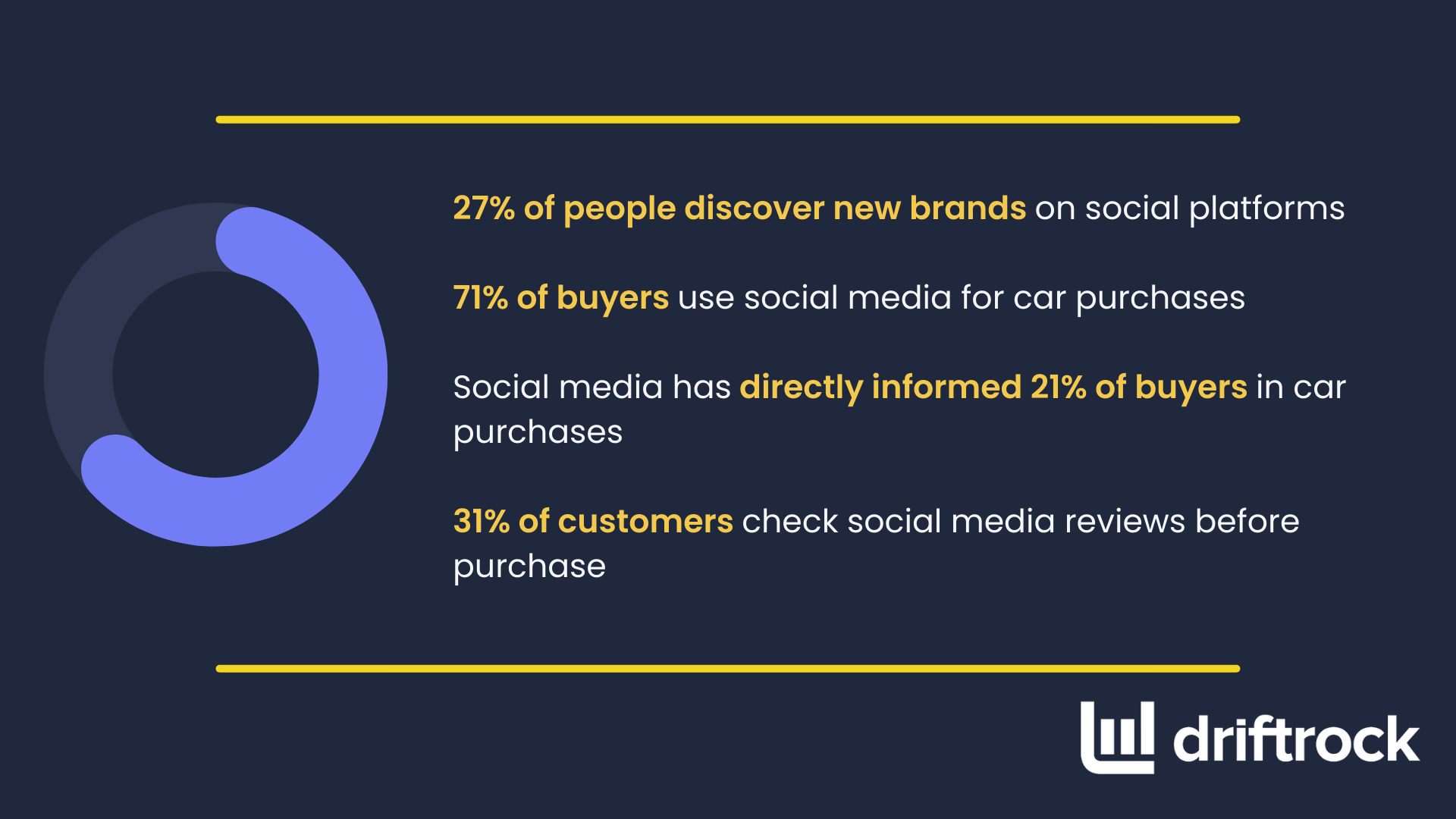
Social media is a powerful channel for pushing leads through the sales funnel to purchase. It's so influential that 27% of people discover new brands on social platforms.
71% of buyers use social media to support their car buying process. And another 21% say that social media has directly informed their transaction.
Another benefit of social media for buyers is reviews. 31% of customers check social media reviews before making a purchase.
Social media's influence isn't lost on the automotive industry. You can use social platforms to:
- Follow the customer during their buying journey
- Drive engagement from lead to sale to post-purchase
- Promote your vehicles
- Engage with existing customers
You also have the flexibility of choosing from multiple social media channels and formats, including:
- Short and long-form videos
- Stories
- Quizzes
- Images
- Carousels, and more.
The next important question we answer is – which social media platforms work best for you?
Automotive social media platforms that drive results
Car buyers visit multiple social platforms during their research. But the top-most ones are YouTube (41%), Facebook (37%) and Instagram (21%).
Let's see how you can bring these platforms into play, plus a few other popular options.
1. Market videos with YouTube
In 2023, as much as 91% of consumers and marketers want to see more videos from brands online.
And YouTube plays a huge role in pushing video marketing ahead. 4 in 10 UK car buyers use YouTube while purchasing their vehicle. It's also the second-most used search engine after Google.
So, what can you do with YouTube?

Source: Volvo, YouTube
Influence potential customers browsing through the platform, looking for options. You can create videos on:
- Product walkthroughs
- New vehicle launches
- Auto events and meetups
- Brand or influencer partnerships
- Reviews from influential experts
- Resources for frequently asked questions (FAQs)
- Authentic customer testimonials
Consider creating both long and short-form videos. YouTube Shorts can bring in engagement with interactive and bite-sized content.
Don't miss the comments section. This is a chance to get insights into the market's perception of you, their preferences, and common problems with a particular aspect of your process or to engage with them.
If you have previously created content that addresses their FAQs, direct buyers to these resources.
2. Reach target consumers on Facebook
Facebook reigns as the largest social media application in the world, with nearly 3 billion users. A large audience translates into more opportunities for reaching the right audience.
You can target audiences whose research falls within your space. Plus, you can connect with them via Messenger in real time, improving the response time and capturing more leads.
Facebook's Automotive Inventory Ads (AIA) is another useful feature focused purely on in-market car buyers. You can optimise the ads to reach and retarget audiences interested in purchasing a car. It's easy to set up and you can even create a catalogue of your offerings instead of individual ads.

3. Engage young car buyers on Instagram
Globally, the two largest audience buckets on Instagram are 18-24 years (31%) and 25-34 years (30.3%).
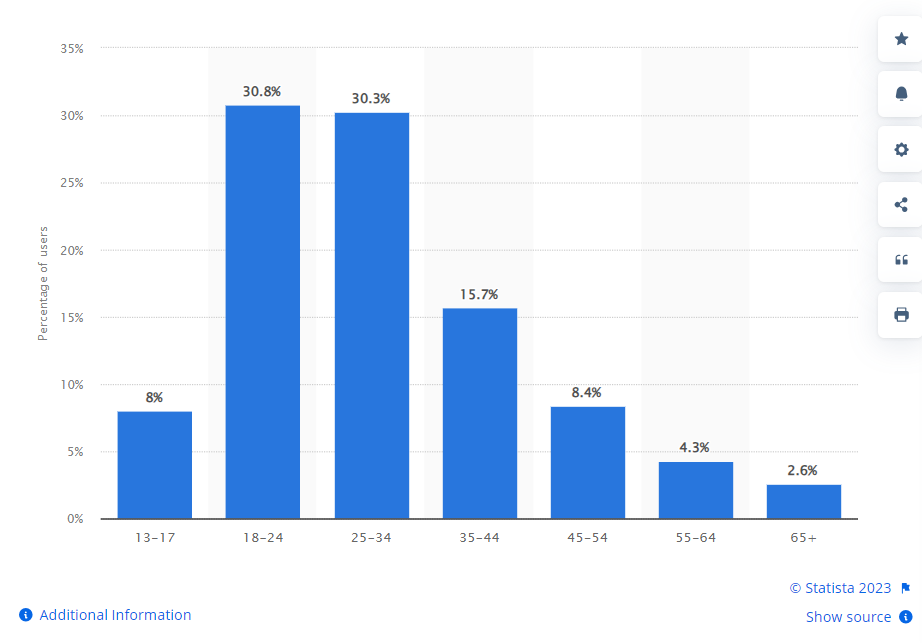
Distribution of Instagram users worldwide (Source: Statista, 2023)
It goes to show the platform's popularity amongst the younger generation. Since the audience distribution and content formats differ for Instagram, you need a tailored strategy.
Firstly, create an Instagram business account. If you already have one, great! If you don't and are using a non-business account, convert it to a business account through Instagram settings. This quick guide can help.
Instagram is all about striking visuals and eye-catching content. Keep it transparent but aspirational. Incorporate a quirky or humorous tone to tell your brand story. Primarily, avoid selling directly (that would otherwise work on Facebook).

Source: Ford, Instagram
Another way to keep it real is Stories. Instagram has multiple options to make your stories interesting. Use Q&As, quizzes and poll stickers to connect with potential customers. Their responses may also act as valuable insights and feedback.
Since Instagram is popular for hashtags, add relevant and branded hashtags to your posts. Also, tag each post's location and associated accounts to increase discoverability.
4. Let authority take centre stage on LinkedIn
LinkedIn offers detailed targeting options. You can not only reach other businesses in the industry but also those looking out for their next big automotive purchase.

63% of users are looking for personal luxury vehicles. LinkedIn is the perfect platform to drive sales among those seeking higher-quality lifestyles.
Also, consider the platform for running targeted ads using first-party data. You can do this using LinkedIn's custom segments for specific interests.
5. Drive discovery & consideration with TikTok
In 2022, more than three-quarters of TikTokers looking to purchase a car used the platform for research. And 67% found a new auto brand or product.
Of all the automotive social media platforms, TikTok presents unique opportunities to create content with trending audio or sounds. It can also be a creative outlet, providing a breather to customers amongst intense competition between automotive brands.
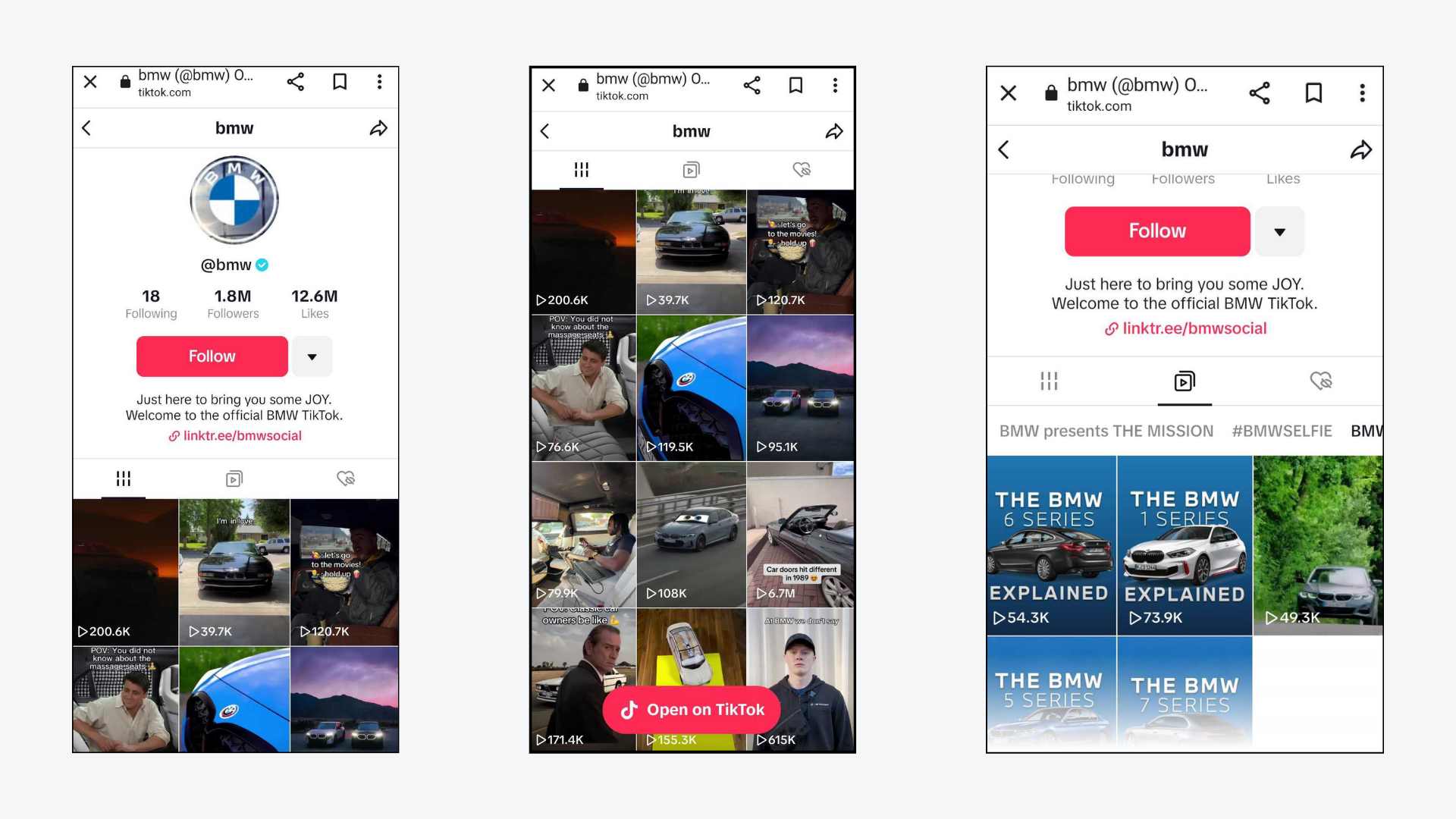
You can also refine targeting on TikTok using first-party data to build lookalike audiences.
6. Use lead generation forms to capture first-party data
Lead generation forms are one of the most effective methods for capturing first-party data from prospects. You can seamlessly sync their details with your CRM, housing their information and preferences for all future campaigns.
Plus, you can follow up with interested leads offline and set up a meeting within a few days or even hours!
All major social media platforms offer lead generation forms. The forms can be attached to multiple content formats-organic and paid. And with such a versatile format at your disposal, you can engage potential customers using meaningful content.
You can also make it easier for them to reach out to you by filling in their details on the platform itself (a pre-fill feature is available).
Social media content ideas to engage automotive buyers
The beauty of social media strategy is that you can explore multiple content formats and ideas. Here are 12 different ideas for automotive social media:
1. Product videos
Naturally, your product takes centre stage. Showcase all the vehicles you sell—in individual or combined videos; that's up to you.

If you're a car dealership, you could post 'car of the week' or 'car of the month' videos to highlight multiple automotive brands and vehicles. Or you could exhibit a particular car's special features like this post from Tesla.
Remember to always pair product videos with a CTA.
2. Social proof
Testimonials from real customers establish trust among prospective buyers. You can amplify these reviews as video and image posts or even stories.
3. Car buying tips
Share resourceful information on purchasing a car for a particular segment or from your business. Educate the buyer on the steps involved in the purchase process, what questions they must ask, and more.
4. Car financing tips

Source: Chevy Dude, YouTube
Financing plays a key role in the buying process. Buyers generally seek information on 'how to get credit' or 'financing your dream car'.
Any resources you share will be considered valuable and show your expertise.
5. Car maintenance tips
Create short, easy-to-understand tutorials for small fixes (which may not need a visit to the service centre or can help during an emergency). Post these as short or long-form videos, carousels and stories.
6. BTS or sneak peeks
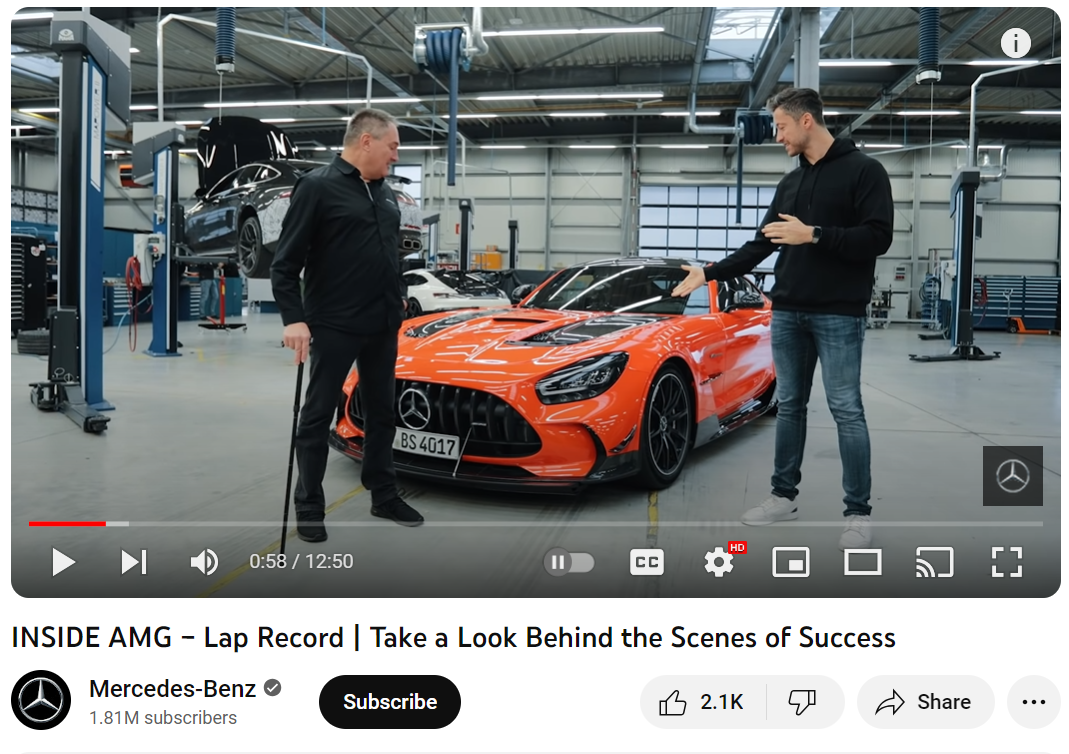
Source: Mercedes-Benz, YouTube
Not to be confused with popular South Korean band BTS, you can post behind-the-scenes video snippets and stories of:
- What goes into making a particular car
- Manufacturing facility
- Tour of the dealership (even cute pet pictures get traction)
- How you run the dealership
- Car selling process
BTS content builds relatability by showing your goofy or non-business side of things. Keep it authentic, and customers will feel more connected to you.
7. Customer deliveries
Post videos, images or stories of happy customers receiving their car. It spreads happiness and encourages prospective buyers to imagine they'll be next.
8. Trivia
Hold trivia quizzes or Q&As specifically on stories to increase engagement.
9. Bust myths
Change isn't easy to accept and with social media's wide reach, it's easy enough for myths to swirl around specific brands or products. Bust these myths with your content. Check out this 60-second video by Vauxhall and carwow for inspiration.
10. Occasions and events
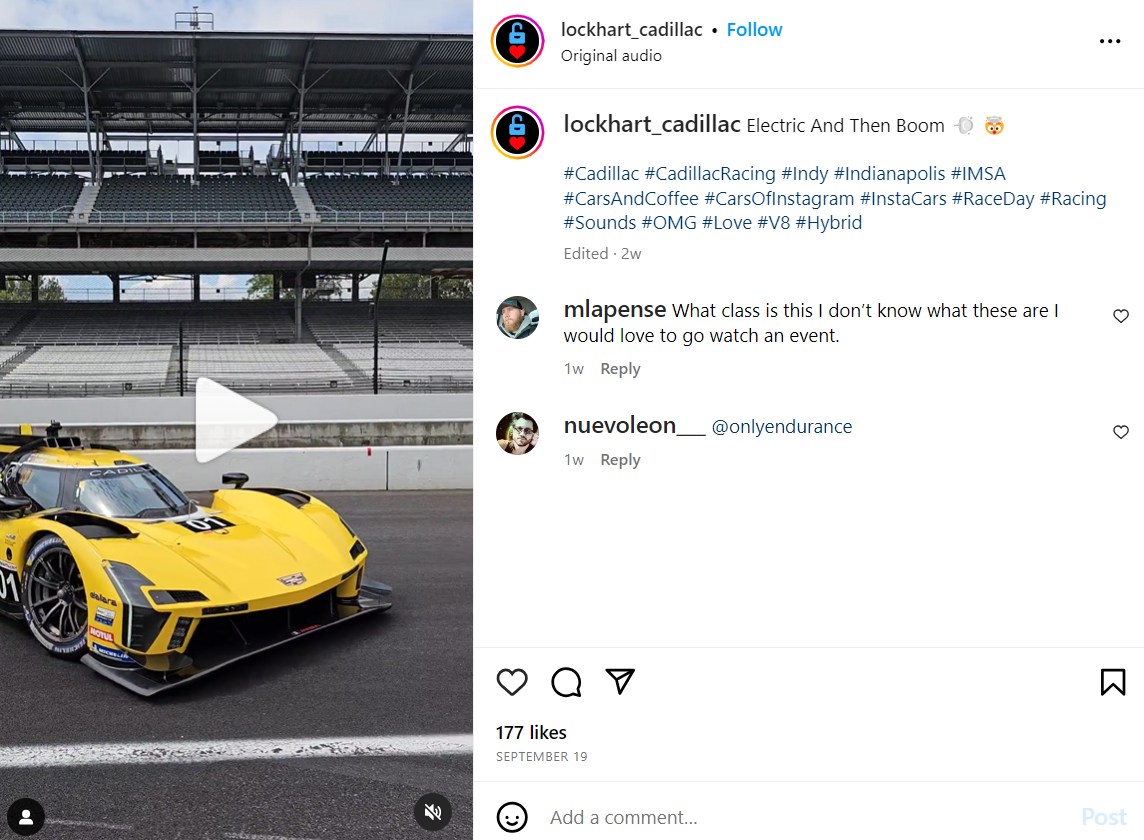
Source: Lockhart Cadillac, Instagram
Include your customers in celebrating occasions or special days. You can also share updates on new launches, community meetups, and car meets, among other events. It builds an empathetic connection with them.
11. User-generated content (UGC)
When followers and customers post their social media content and tag you, reshare the post (provided it's relevant to your business). You can incentivise them with offers or discounts.
12. Interviews
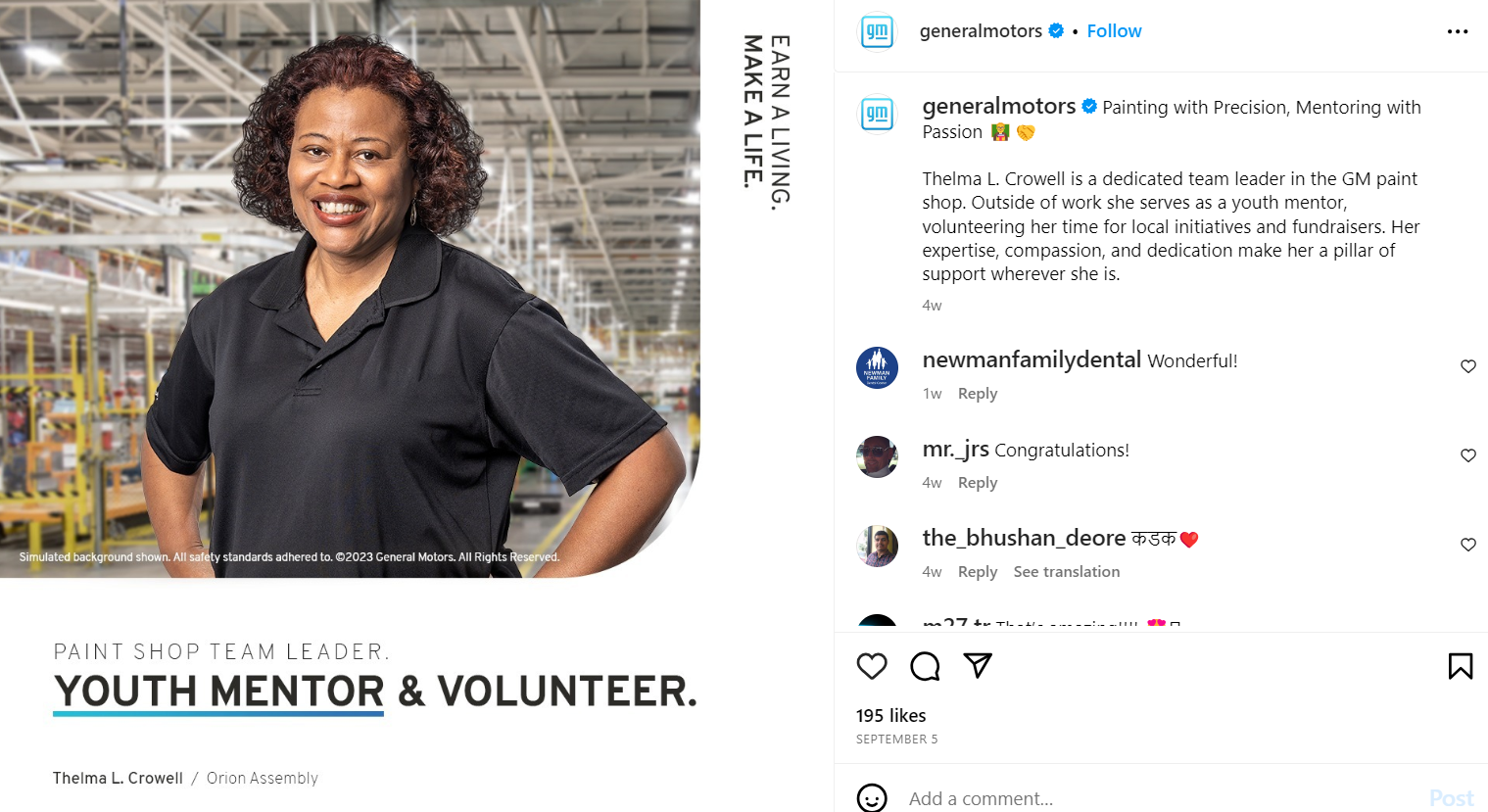
Share snippets, full-length videos, carousels, stories, images, and links to articles of interviews with key figures in your organisation. These could be the C-suite, brand ambassadors and lead designers or engineers, among other important persons.
Social media advertising for the automotive industry
Social media platforms know they play a consequential role in the buyer journey. And so they offer several business-friendly advertising options and strategies.
But it's not just helpful for businesses. 28% of internet users also discover new brands through social media ads.
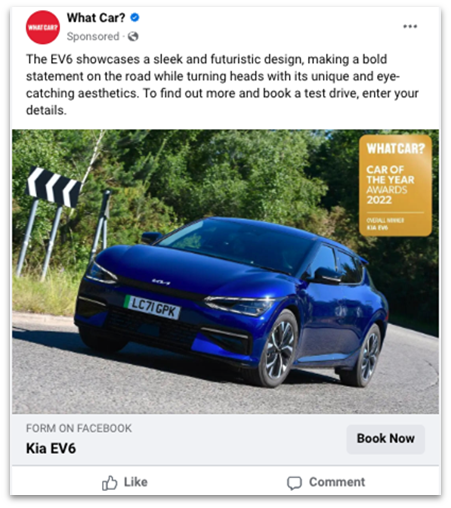
Below are the different advertising formats you can choose from:
- Image ads
- Video ads
- Carousel ads
- Stories ads
- Lead generation form ads
- Message ads
- Product ads
- Text ads
The temptation to go overboard with automotive social media ads can be strong after seeing so many options. However, too much of anything can have a negative impact.
Follow these best practices to set up an effective social media strategy for advertising:
- Determine your marketing or advertising goals, target audience, audience segments, platforms, content purpose, budget and metrics before running each campaign.
- Conduct A/B testing for each campaign. You can experiment with multiple elements—image copy, image visuals, ad copy, CTA, and more.
- Rotate ads within a campaign to avoid creating ad fatigue for customers.
- Customise ads for each social media platform and audience preference. For instance, humour works well where the customers go to relax or entertain themselves (like Instagram and TikTok), while a platform like LinkedIn may need a different approach.
- Stick to high-quality visuals, interesting stories, educational videos and engaging elements in the ad content.
- Direct social media audience to your website or custom landing page using CTAs. These landing pages could showcase your intended or full inventory of automobiles. It induces consideration.
- Whenever possible, create dedicated landing pages for each campaign. Visitors don't have to search for specific information amongst other content on the website.
- Make the most of custom and lookalike audiences to refine your ideal customer profile (ICP).
- Retarget interested prospects. But maintain an optimum gap between subsequent retargeted ads.
- Study your competitors' social media content. Find out what works for them and what doesn't. Incorporate adjustments into your campaign wherever needed.
While you can set up the best-performing campaigns, none will come to fruition if you don't know what metrics to chase.
Measuring social media strategy success
Choose the right set of metrics for you to understand how you fare with automotive social media marketing (organic and paid). We've listed ten metrics for you to consider:
1. Engagement
Includes comments, likes, shares, reactions and number of followers.
2. Reach and impressions
Reach shows how many people viewed your social media posts. Impressions show how many times these people viewed your content.
3. Follower growth
If more people follow your brand over a specific period, you're doing something right.
4. Response time
Shows the average time you take to respond to messages and comments on your social accounts. Better response time helps build a better social community.
5. Referral traffic
It's the website traffic generated from social media. Referrals show you if your social media content is nurturing the leads successfully to conversion.
6. Sales
You can track sales through leads coming in from social media and resulting conversions. Use lead management software like Driftrock to help you track your buyer throughout their journey.
7. Return on investment (ROI)
ROI signifies how much revenue you generate from social media compared to the costs incurred.
8. Net promoter score (NPS)
NPS shows how likely existing customers are to recommend your business to others. This data can be collected from online feedback and survey forms.
9. Audience sentiment
Reflects how your customers perceive you. It could be positive, neutral or negative. A social listening tool can give you in-depth insights into audience sentiments.
10. Share of voice (SOV)
SOV determines your brand's ranking in comparison to competitors. You can use marketing analytics tools or platforms like Similarweb to find this out.
Automotive social media marketing campaigns in the real world
Are you inspired to create new social media campaigns or upgrade your existing ones? Pick some cues from these real campaigns.
1. BMW: Born Electric
Fun fact: BMW's 'Born Electric' campaign is over a decade old!
The brand refreshed the campaign with its BMWi range by celebrating its 10 year-mark in 2021. It's the brand's electric range that was introduced with this campaign.
BMW led into the campaign with videos on YouTube. Multiple posts on Instagram, Facebook, TikTok and LinkedIn followed these videos.
Instead of focusing on selling, the brand engages consumers using content beyond cars. It aims to create an emotional connection for its products through consistent messaging.
It wasn't just the brand, however. Even car dealerships promoted the range on their respective social media accounts.
Plus, the brand used celebrity appeal to amplify its flagship models. This included heavyweights like Arnold Schwarzenegger and Salma Hayek.
2. BMW: Capturing TikTok audience in Spain
BMW ran another successful social media campaign, this time in Spain. The campaign focused on generating leads through TikTok
Why TikTok? Because short-form videos on the platform are popular amongst all age groups today.
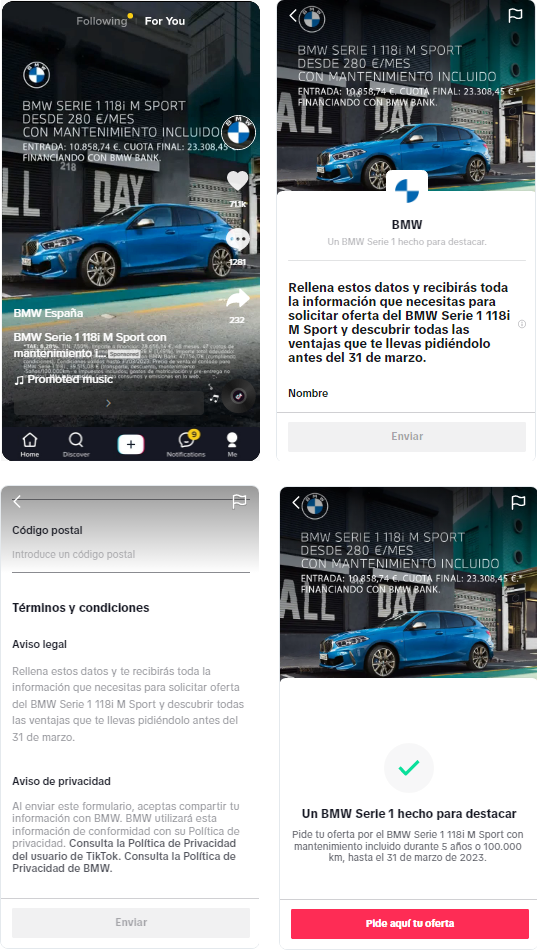
BMW used an eye-catching video, linking it to a lead generation form. The form seamlessly collected interested leads' details using the pre-fill option. It quickly reached out to these potential buyers by validating their email IDs and syncing their data with the CRM.
As a result, BMW improved its lead quality and received 47% lower CPL than other ad formats on social media.
3. CarMax: Love Your Car
In the 'Love Your Car' campaign, CarMax extended its 7-day money-back guarantee to 30 days. It also introduced a '24 hours' test drive feature.
The dealership extensively amplified these guarantees through videos on YouTube (some even featuring celebrities).
CarMax also made the most of social media through different posts, including buyers receiving delivery of their cars.
Leverage CRM data collected from social media for future automotive marketing
To excel at social media marketing, it's not just about developing current campaigns. Use social insights to build stronger marketing strategies in the future.
Sync your CRM with social media campaigns to collect details shared by leads through lead generation forms automatically. Leverage this first-party data to refine your content goals, targeting and messaging.
Use this information to retarget leads through personalised emails or display and search ads. You could also use the insights to create content that matches specific pain points. Amplify these through segment-specific case studies, review videos or resource videos.
Finally, you can seamlessly follow up with interested prospects to schedule test drives or consultations.
Driftrock's lead management platform helps you build integrated marketing campaigns and increase conversions. Get in touch to learn more ways Driftrock can boost social media marketing.




